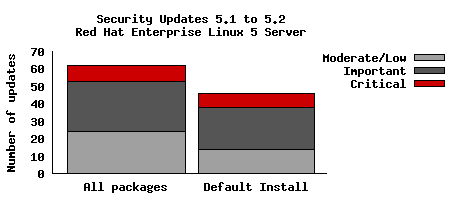26 May 2008: Enterprise Linux 5.1 to 5.2 risk report
Red Hat Enterprise Linux 5.2 was released last week, around 6 months since the release of 5.1 in November 2007. So let's use this opportunity to take a quick look back over the vulnerabilities and security updates we've made in that time, specifically for Red Hat Enterprise Linux 5 Server.The graph below shows the total number of security updates issued for Red Hat Enterprise Linux 5 Server starting at 5.1 up to and including the 5.2 release, broken down by severity. I've split it into two columns, one for the packages you'd get if you did a default install, and the other if you installed every single package (which is unlikely as it would involve a bit of manual effort to select every one). So, for a given installation, the number of packages and vulnerabilities will probably be somewhere between the two.

So for a default install, from release of 5.1 up to and including 5.2, we shipped 46 updates to address 119 vulnerabilities. 8 advisories were rated critical, 24 were important, and the remaining 14 were moderate and low.
For all packages, from release of 5.1 to and including 5.2, we shipped 62 updates to address 179 vulnerabilities. 9 advisories were rated critical, 29 were important, and the remaining 24 were moderate and low.
The nine critical updates were in five different packages:
- Four updates to Firefox (November, February, March, April) where a malicious web site could potentially run arbitrary code as the user running Firefox. Given the nature of the flaws, ExecShield protections in RHEL5 should make exploiting these memory flaws harder.
- An update to the GnuTLS library (May), where
a remote attacker who can connect to a server making use of GnuTLS could
cause a buffer overflow. In Red Hat Enterprise Linux 5, the CUPS print
server uses GnuTLS.
- An update to MIT Kerberos (March),
where a remote attacker who can conect to the krb5kdc or kadmind
services could cause a buffer overflow.
- An update to OpenPegasus
(January), where
a remote attacker who can connect to OpenPegasus could cause a buffer overflow.
The Red Hat Security Response Team believes that it would be hard to remotely
exploit this issue to execute arbitrary code, due to the default SELinux
targeted policy, and the default SELinux memory protection tests.
- Two updates to Samba (November, December) where a remote attacker who can connect to the Samba port could cause buffer overflows. In addition to ExecShield making this harder to exploit, the impact of any sucessful exploit would be reduced as Samba is constrained by an SELinux targeted policy (enabled by default).
Updates to correct all of these critical issues were available via Red Hat Network either the same day, or one calendar day after the issues were public.
To get a better idea of risk we need to look not only at the vulnerabilities but also the exploits written for those vulnerabilities. A proof of concept exploit exists publicly for one of the Samba flaws, CVE-2007-6015, but we are not aware of public exploits for any other of those critical vulnerabilities. Also of high risk was an important "zero-day" exploit affecting the Linux kernel where a local unprivileged user could gain root privileges. Red Hat Enterprise Linux 5.1 was affected and a fix was available two calendar days after public disclosure.
Red Hat Enterprise Linux 5 shipped with a number of security technologies designed to make it harder to exploit vulnerabilities and in some cases block exploits for certain flaw types completely. For the period of this study there were two flaws blocked that would otherwise have required updates:
- A double-free flaw in CUPS. The glibc pointer checking limited the exploitability of this issue to just a crash of CUPS and not the ability to execute arbitrary code. code execution. We still issued an update, as a remote attacker could trigger this flaw and cause CUPS to crash.
- An uninitialized pointer free flaw in unzip, caught by the glibc pointer checking. As exploitation of this flaw results in just a crash of a user application, no updates were needed.
This data is interesting to get a feel for the risk of running Enterprise Linux 5 Server, but isn't really useful for comparisons with other versions or distributions -- for example, a default install of Red Hat Enterprise 4AS did not include Firefox. You can get the results I presented above for yourself by using our public security measurement data and tools, and run your own custom metrics for any given Red Hat product, package set, timescales, and severities.
See also 5.0 to 5.1 risk report
Created: 26 May 2008
Tagged as: metrics, red hat, security
